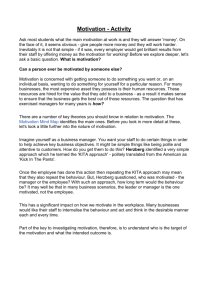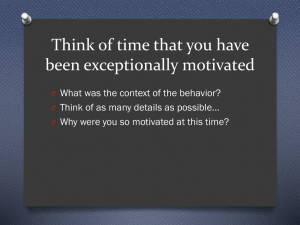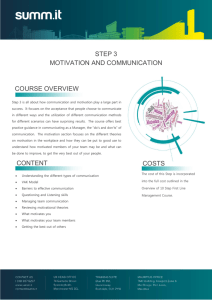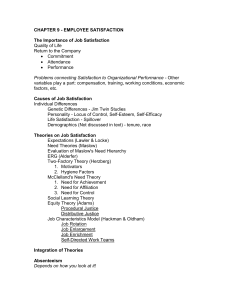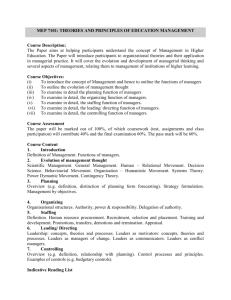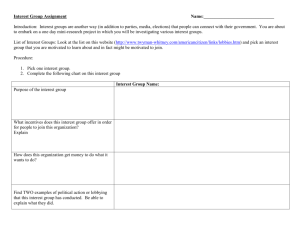Introduction Motivation comes from the Latin word mover
advertisement
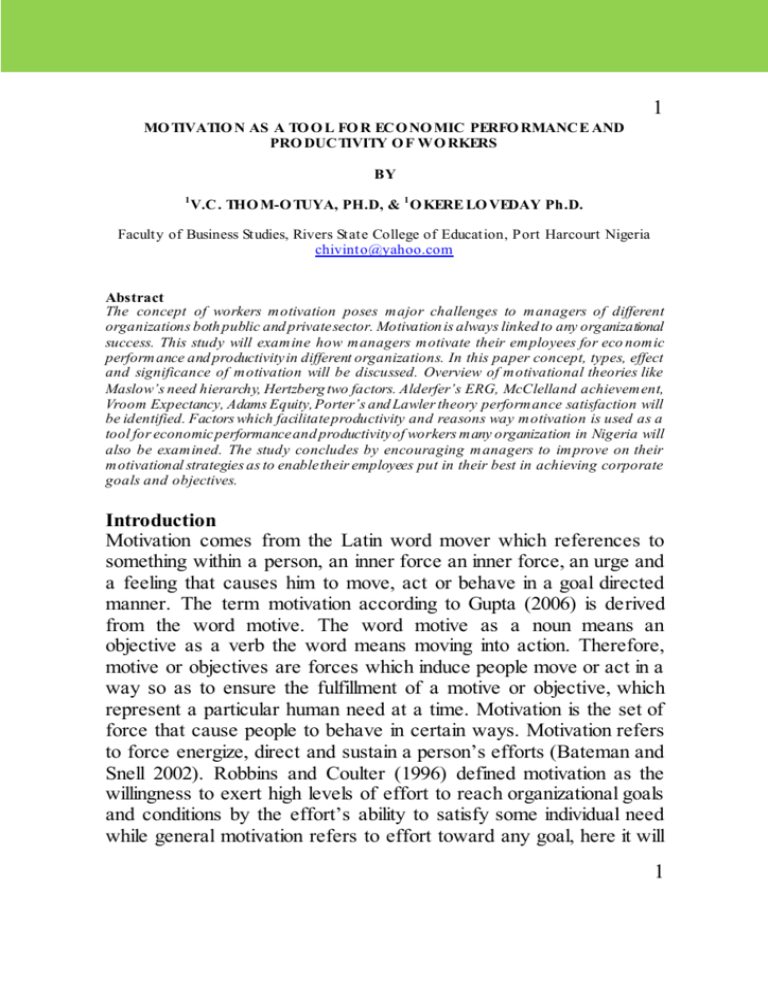
1 MO TIVATIO N AS A TO O L FO R ECO NO MIC PERFO RMANCE AND PRO DUCTIVITY O F WO RKERS BY 1 V.C. THO M-O TUYA, PH.D, & 1 O KERE LO VEDAY Ph.D. Faculty of Business Studies, Rivers State College of Education, Port Harcourt Nigeria chivinto@yahoo.com Abstract The concept of workers motivation poses major challenges to managers of different organizations both public and private sector. Motivation is always linked to any organizational success. This study will examine how managers motivate their employees for eco nomic performance and productivity in different organizations. In this paper concept, types, effect and significance of motivation will be discussed. Overview of motivational theories like Maslow’s need hierarchy, Hertzberg two factors. Alderfer’s ERG, McClelland achievement, Vroom Expectancy, Adams Equity, Porter’s and Lawler theory performance satisfaction will be identified. Factors which facilitate productivity and reasons way motivation is used as a tool for economic performance and productivity of workers many organization in Nigeria will also be examined. The study concludes by encouraging managers to improve on their motivational strategies as to enable their employees put in their best in achieving corporate goals and objectives. Introduction Motivation comes from the Latin word mover which references to something within a person, an inner force an inner force, an urge and a feeling that causes him to move, act or behave in a goal directed manner. The term motivation according to Gupta (2006) is derived from the word motive. The word motive as a noun means an objective as a verb the word means moving into action. Therefore, motive or objectives are forces which induce people move or act in a way so as to ensure the fulfillment of a motive or objective, which represent a particular human need at a time. Motivation is the set of force that cause people to behave in certain ways. Motivation refers to force energize, direct and sustain a person’s efforts (Bateman and Snell 2002). Robbins and Coulter (1996) defined motivation as the willingness to exert high levels of effort to reach organizational goals and conditions by the effort’s ability to satisfy some individual need while general motivation refers to effort toward any goal, here it will 1 2 refer organizational goals. Jones and George (2003) defined motivation as psychological forces that determine the direction of a person’s behaviour in an organization, a person’s level of effort and a person’s level of persistence in the obstacles. Motivation may be defined as a willingness to exert effort to achieve a goal or objective for reward (Thom-Otuya 2005). Motivation might be define as a planned managerial process which stimulates people to work to the best of their capabilities for the most effective and efficient realization of the common objectives of the enterprise by providing them with motives to work for based on their unfulfilled needs. It is infact pressing the right button to get desired Human behaviour (Hartzell 2006). Hertzell (2006) defined performance, as the way of job task is the one by an individual, a group or an organization. Productivity could be defined as a measured relationship between the quality (and quality) of resources required for production, productivity in essence a measure of the work efficiency of an individual, work unit or entire organization (Hertzell 2006). Motivation is a force that results from an individual’s desire to satisfy his needs of hunger, thirst, and social approach. It is a psychological tool which managers in organization adopt to raise the level of individual’s contributions to organizations’ goals and performance. Employees of a company can exhibit a wide range of commitment and performance, ranging from bare minimum necessary to remain employed to the full maximum effort. Operations depend on the efforts of employees to products the ducts or services they offer for sale. Managers are responsible for gaining employees cooperation in seeing that the company objectives are achieved hence, are interested in directing their behaviour. Human behaviour is energized, directed and sustained by motivation. An employees motivation is to some degree related to the rewards the employee receive through participation in the organization. 2 3 Process of Motivation UNFULFILLED NEEDS INCENTIVE BEST ATTAINMENT OF COMMON OBJECTIVES ACTION FULFILLMENT OF UNFULFILLED NEED Fig. 1: process of motivation (Gupta 2006) Concept of Motivation The following are the outstanding features of the concept of motivation. i. MOTIVATION IS NEED BASED: If there are no needs of individuals. The process of motivation fails. ii. A thing or reward offered for stimulating people to work in the desire manner achieving or fulfilling objectives or need is an incentive or a motivator (i.e. one which motivates) for example the basic needs are the motives for which people work and money is the incentive (or motivator for) promised to people for that purpose. iii. Motivation is planned process to produce a desired result by stimulating and influencing human behaviour for the best realization of the common objectives. People differ in their approach to respond to the process of motivation, as no two individuals could be motivated in exactly similar manner. iv. Basic motivation to work comes from within the individuals. It is an inner drive forcing people to work for the fulfillment of their basic need. 3 4 v. Every manager from the highest to the lowest authority, in the management hierarchy is responsible for powers of a manager to motivate subordinates. Some of the limits, which restrict the power of managers to motivate, may be company rules and policies on wages, salaries, fringe benefits, promotions etc. vi. Motivation may be positive or negative. A positive motivation promise incentive to people, a negative motivation threatens the enforcement of disincentives. vii. Motivation is a continuous process, which is both necessary and possible. It is necessary because the moment there is a lack of motivation of people they would not work whole-heartedly. It is also in view of the fact that not only are human needs unlimited, these are also recurring nature. Types Of Motivation Thom-Otuya (2005) identified three (3) types of motivation. They are: (1) (2) (3) Positive motivation Negative motivation Self motivation 1. Positive Motivation: Is a human relation and leadership approach whereby subordinates follow the leaders will because of some of possible gain, reward or satisfaction they expect to get. 2. Negative Motivation: On the other hand influences others to follow the leader’s will but not because of any expected advantage but of fear of punishment of the application of certain sanctions such as losing money, recognition or even one’s job. Authority and punishment are used to make people do what management wants them to do. 4 5 3. Self-Motivation: The best form of motivation is selfmotivation. This type of motivation comes from within the individual. His own motivators are his own personal drives to achieve his ambition and goals. The company may provide the necessary motivations such good environment but if he lacks personal drive or the will to forge ahead and achieve no amount of motivation will make him strive to great achievement. The employee needs personal initiative and motivation to achieve superior performance. Positive Motivation The following are some of the positive factors in motivating people. a) Money: The most commonly used incentive to stimulate the worker to greater production and efficiency is monetary remuneration. Unions usually ask for increased pay as a part of their bargaining demand knowing, this is what the employees want. While money is important for providing the material does not last long. b) Job Security: Employees want to feel secured in their jobs and would prefer lower paying jobs that are permanent to higher paying ones without security of tenure. c) Praise and recognition: Whenever a worker accomplished a good job, it is good to recognize such accomplishment by praising or rewarding him so he would be motivated to always do a good job. d) Sense of belonging: The main function of induction or orientation of the new employee in the company is to make him feel that he is part of the group and that the group accepts and recognizes him as a member of the team. If he feels that he does not belong to the group, he gets dissatisfied and disappointed. 5 6 e) Competition: When done properly competition can be a good motivator for the employee because it encourages creativity, initiative, better performance and improved production, with the use of records and charts, management can encourage employees to work harder to best their previous records of performance. f) Delegation of responsibility and authority: Responsibility and authority delegated to a subordinate are great motivators. They stimulate the employee’s interest and provide human opportunity for development. The employee takes this as recognition of his ability to perform his job well. g) Employee participation: Making employees participation in meeting conferences and work in committees are forms of employee development and be a strong motivator. Participation in decision-making stimulates employee’s interest for greater production, provides job satisfaction and creates in him a feeling of importance. h) Sincere interest in subordinates: Taking sincere interest in subordinates is a human relation approach in motivating people. The supervisor gets immediate results from his subordinates if the letter knows that their superior is sincerely interested in their welfare. Effect of Motivation The following effects of motivating employees been established by Thom-Otuya (2003) in Sison (1981). (a) i) That the motivated employees achieve high output and produces good quality products and services. 6 7 ii) That employees who are properly motivated are more careful in the use and care of machines and minimize or prevent losses or waste. iii) The employees accept willingly the changes made by management provided that the changes to be made by management provided that the change to be made have been previously explained to and understood by them to the change. iv) The motivated employees willingly respond in times of emergency or during the periods or occasions requiring special effect, overtime and the like. v) That with motivated employees the problems of discipline is minimized. Significance of Motivation Gupta (2006) identified some significance of motivation. They are; 1. Motivation is the soul of the managerial process: Just as when the soul is taken away from the body of a living being, the living being is rendered managerial process, the managerial process becomes meaningful and futile incapable of providing any fruitful results whatsoever. 2. Best attainment of common objective: Motivated employees put in their best efforts, towards the attainment of common objectives of the enterprise. Motivation not only facilitating the attainment of objectives, is also leads to their best realization- in teams of time spent and effort involved. 3. Best utilization of resources: Human factor being the only active factor of production- is responsible for the best or the worst utilization of resources of the organization. Motivated 7 8 employees make the best utilization of all resourcesmachine, materials, technology and other physical work facilities, leading to cost minimization and profit maximization. 4. Industrial peace: Motivation in a sense implies taking care of needs of individuals by the management. This leads to the development of excellent and friendly human relations between management and the workforce. As such industrial peace. Is endured. 5. Stability of workforce: Motivation directly and indirectly results in the stability of workforce, necessitating only the minimum inevitable labour-turnover in a way, it is only frustrated employees who are dissatisfied with management and who thinks of leaving the organization seeking better employment avenues outside. A motivated and stable workforce is perhaps the best asset an organization can boost of. 6. Morale and job satisfaction: A persistent state of high motivation goes a long way in building up the morale (.e. favourable attitude towards work) of employees. Employees with high morale become dedicated to the organization and benefit the organization substantially. Not minding this such employees derive a lot of job satisfaction having performed their jobs in the best manner which makes them happy, in their personal lives . 7) Coordination facilitated: Motivation facilities achieving co-ordination. Infact, motivated one another by appreciating their mutual problems and resolving cause differences in an amicable manner. Since the root cause of lack of coordination is mutual differences in approach as to the 8 9 attainment of common objectives, motivation helps n achieving co-ordination in the aforesaid manner. 8. Reduced need for supervision: Motivated employees in a way are some what self-starters. There is a reduced need for supervision over them. In so far their speed is concern. This reduced need for supervision requires a reduction in the managerial cost. It also helps widen span control (or span of management) in the ultimate analysis. 9. Minimum resistance to change: Motivated employees better appreciate the management viewpoint as to the introduction of organizational changes. Their resistance to organizational changes affect their interest extremely. An Overview of Some Motivation Theories Theories Early Theories Contemporary theories 9 10 Scientific M anagement Approach Content Theories Human Relations M ovement Process Theories 10 11 * Maslow’s Need Hierarchy Theory * Herzberg’s Two-Factor theory * Aiderfer’s ERG Theory * McClelland’s Achievement Theory * Vroom’s Expectancy theory * Adam’s equity theory * Porter and Lawler’s Theory Fig 2. Theories of motivation (Inyang 2004) Early Theories A scientific management approach: Fredrek Taylor sees man as rational and hedonistic being especially motivated by economic incentives that is money Taylor’s approach according to Inyang (2004) represents both a content and process perspective of motivation. This economic view of human motivation held away for a long time before scholars began to note it’s weak explanatory power in terms of understanding motivation as complex process. a) The human relation movement: The foundation for the human relations movement was laid by Ectrin Mayo and his colleagues. This approach to motivation suggests that employees are motivated by things other than money that employees as social beings are motivated by social-psychological factors and favourable work environment, with favourable attitudes, employees will experience job satisfaction and increased performance Inyang (2004). The recognition that employees need social interest on the employees work in the or organization can result in improved employee motivation. This is the social concept of motivation. 2) Contemporary Theories The contemporary theories are divided into two major competing theories, they are: a) Content theories: These theories attempt to explain those specific things which actually motivate people to work. Theories in this classification are interested in identifying peopel’s needs and their negative strengths and the goals they pursue in other to satisfy these needs. The main emphasis of the content theories is on what motivates individuals. The needs of the individual may reflect either physiological or psychological deficiencies. Theories are. Maslow’s Need Hierarchy A.H Maslow an eminent American Psychologists has advance needs known as Maslow’s needs of Hierarchy. Maslow provided the following classification of human needs. 11 12 i) Physiological (or basic or survival) needs: includes needs for food, drink, clothing shelter rest and other similar has requirement. ii) Security (or safety) needs: This could be divided into three types as shown by the following change (Gupta 2006). Security (Or Safety) Needs ECONOMIC SECURITY PHYSICAL SOCIAL SECURITY NEEDS SECURITY NEEDS NEEDS Fig: 3 Security (Or Safety) Needs v) a) Economic security needs: A man want economics security that is an assurance about fulfillment basis needs on a continuous or permanent basic. These need just an extension of basic needs: b) Physical security needs: These needs include protection against fire, accident (including accidents terrorism and other types of physical dangers. c) Social security needs: These include a need for security in old age, state of illness or permanent incapacity to work caused by some disablement. iii) Social (or affiliation) needs: Since man is social animal, needs become important for all those who live in societies and work in the company of others. These needs include, need for love and affection, a sense of belonging to the work group, acceptance by the work group etc. iv) Ego (or esteem) needs: Ego or esteem needs may be self-confidence, dependence while the latter includes power over others; prestige or reputation enjoyed in the work-group, respect or recognition on form of others etc. Self-realization (or self-actualization) needs: Some persons have a desire to develop themselves to the fullest extent by realizing or exploiting their potential or capacities maximally. In simple words these needs reflect a desire to become what one is capable of becoming. 12 13 Fig.4: Malsow Hierarchy of Needs 2. Herzberg two-factor theory Fredrick Herzberg’s two factors theory of motivation based on his research conducted among two hundred (2009) accountants and Engineers of Pittsburgh area of USA who were asked the following two questions. i) ii) What is about your job that you like? What is about your job that you disliked? Accordingly he put the responses into two categories. Factors that prevent dissatisfaction known as hygiene factors. Factors that have positive effect on job satisfaction known as motivation. Hygiene Factors (Or Maintenance Factors Or Dissatisfies) The first category of factors in Herzberg two factor theory are called hygiene factors. The presence of these factors prevent dissatisfaction on an helps to maintenance factors), while the absence of these factors leads to dissatisfaction also called dissatisfies. Hertzberg mentions the following as Hygiene factors. i) ii) iii) iv) v) vi) vii) viii) ix) x) Salary Job Security Working Conditions Company Policy and Administration Technical Supervision Interpersonal Relationship with Peers Interpersonal Relationship with Supervisors Interpersonal Relationship with Subordinates Status Personal life Motivational Factors or Satisfiers The second category of factors in Hertzberg two factor theory are called motivators or satisfies. An increase in these factors will have no effect on motivation. 13 14 The following factors are motivators i. ii. iii. iv. v. vi. Achievement Recognition Responsibility Advancement Opportunity for growth Work itself Alderfer erg Theory: Alderfer (1972) modified Maslow’s need hierarchy and collapses his five levels need to three levels of needs. (ERG). a) b) c) Existence needs Relatedness needs Growth needs Like Maslow, Alderfer suggest that individual’s progress through the hierarchy from existence needs to relatedness needs, growth needs, as lower level needs are move continuum that hierarchical levels, individuals may also progress down the hierarchy. Mcclelland Achievement Motivation Theory: Psychology David McClelland in 1961 made an extensive research on needs for achievement, affiliation on and power (Jones and Georges (2003). a) The need for achievement: Is the extent to which an individual has a strong desire to perform challenging tasks well and to meet personal standards for excellence people with high need for achievement of ten set clear goal for themselves and like to receive performance feedback. b) The need for affiliation: Is the extent to which an individual is concerned about establishing and manufacturing good interpersonal relations being liked and having other people around them get along with each other. c) The need for power: Is the extent to which an individual desires to control, or influence others. Process theories: These are those theories, which attempt to identity the relationship among the dynamic variables, which make up motivation. The theories and concerned more with new behaviour is initiated, directed and sustained. The theories place emphasis on the actual process of motivation: the theories are: i. ii. iii. Vroom expectancy theory Equity theory Porter and Lawler’s Performance Satisfaction Theory Performance Satisfaction Theory Ihejiamgizu (2009) define productivity as the amount of output production by each unit of input, where outputs are measured by physical units. Productivity as a measure of overall efficiency effectiveness and performance of the individual that productivity means quality of output, workmanship, adherence to complaint customer satisfaction, absentee and turn over rates, absence disruption, trouble and other 14 15 evidence of difficulty. In organization as well as such qualitative measurement as units produced or volume of sales. In any business enterprises, are that a worker has to sell is his productivity by his skill which itself depends on his natural aptitude and on his training and education. It also efficiency with which his work is organized. Anything which reduces the worker’s productivity is a direct attack on the worker’s interest. Factors Which Facilitate Productivity Ihejiamazu (1996) in Ubeku (1983) identified the following factors in the Nigeria situation which can promote productivity i. ii. iii. iv. v. vi. A good infrastructure Adequate Machinery Available and Adequate materials Intelligent use of capital A good organizational structure providing for clear lines of communication, authority and accountability via, a trained and knowledgeable management. A committed and motivated staff. Motivation as A Tool For Economic Performance And Productivity of Workers The growth of any existing organization depends largely or how workers are prepared to work and increase their productivity and performance when they are motivated. Motivation can occur in different shapes and forms. It may include increase in salaries recognition, self-actualization, safety, discipline etc. Abraham Maslow and Hertzberg contributions in motivation play a significant role in workers performance and productivity. Most business firms are borrowing a leaf from the managerial scholars Motivation a tool for Economic Performance Thom-Otuya & Okere depending on situation approach and the ideas on asmotivation although, motivation can work effectively circumstance surrounding of firms motivating their workers is to enhance productivity and performance. Though this measure, are organization can easily achieve its goal. If workers are working very well and highly motivated, productivity will increase. When productivity improves, the resultant effect and profit, Growth creation of employment and social responsibility program will be implemented. The nation’s economy will equally grow. Organization adhered strictly to condition of services that will motivate workers. They select policies and procedure to motivating and controlling the behaviours of its members. Favourable behaviour can be rewarded with high pay. Informal rewarding, fringe benefits. Undesirable behaviour can be restrained by various forms of punishment such as reduced salaries, layoff, discharge and other disciplinary actions. There can be no certainty that systems of rewarding and punishment are managed fairly. Most organizations try to achieve fairness in reward and punishment decision, the fact that managerial work is not easily measured makes fairness an elusive goal. A major approach to more effective motivation has appeared in various forms of attention to job design and more restrained. Herzberg’s motivation concepts greatly affected this movement by emphasizing the importance of the intensive motivations of work itself. Workers performance and productivity can result form the number of hours given to do their work. It is relevant to note that some essential factors managers put into consideration in relationship with motivation include salaries of workers, the environment worker operate. The number of hours they operate, safety of workers. The recognition of these factors help firm to create a favorable relationship with the workers. Such relationship avoid industrial dispute which might result to strike. Organizations fully aware of all these will ensure that the firm labour union and the management are in good relationship. Conclusion 15 16 The concept of motivation is very relevant in worker performance and productivity in any business organization; corporate objectives can be derived or defeated if motivation of workers is ignored. The emergence of labour union to address the problem of workers is very significant. Labour union ensure the condition of service that will help worker improve on the performance and productivity is implemented. Corporate bodies should be able to motivate their worker to enable them change their attitude towards Motivation a tool felling for Economic Thom-Otuya & Okere work andashave of thePerformance job satisfaction. The survival of companies today depends on how workers are motivated. Undoubtedly corporate profit, growth survival etc. emanate from worker hard work when motivated. References Gupta, R.N. (2006) Business Organization and Management Remigrations Deihi S. Chand and Company Ltd. Hertzell, Daniel (2006) Dictionary of Management: New Dcelhi Academic (India) Publishers. Jones, G.R. and George J.M. (2003) Cotemporary Management. New York Mcgrail Hill. Third Edition. Inyang, B.J. (2004) Organization Behaviour: (A Managerial Perspective) CalabarMaerb Publishers. Ihejiamaizu, E.U. (1996) Administrative and Organization Theory: Calabar Ephriam Associate. Bateman, T.S. and Snell S.A. (2000) Management Competition in the New Era: New York Mc -Grawhill 5th edition. Robbins S.P. and counter M. (1996) Management. New Jersey: Prentice-Hall Inc. 5th Edition. Sison, P.S. (1981) Personnel and Human Resources Management Manlla- Philippines Rex Bookstore. Thom-Otuya, V.C. (2003) Personnel Management (Human Resource Approach) Port Harcourt: Izreale Prints. Thom-Otuya, V.C. (2005) Organizational Behaviour A practical approach, Port Harcourt: Nice Prints International. 16

